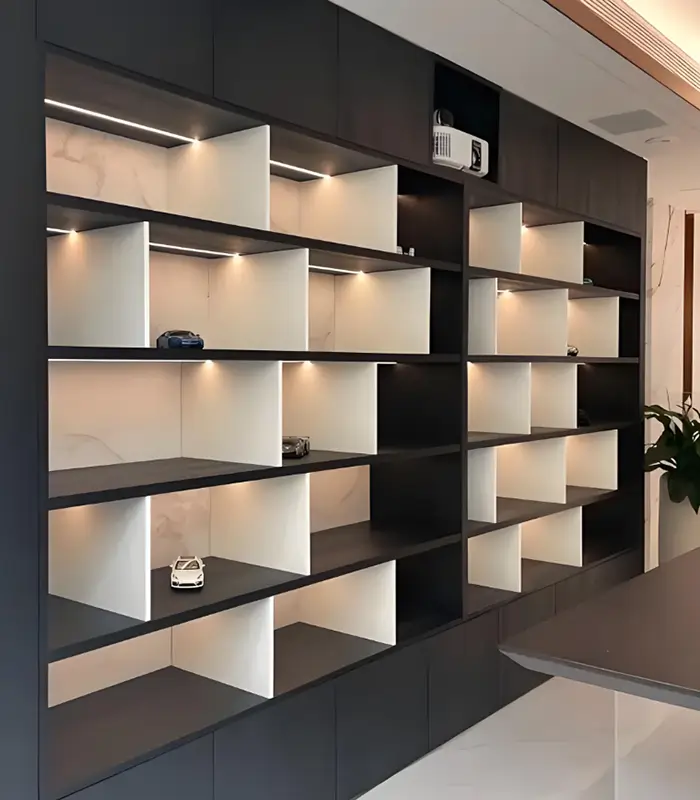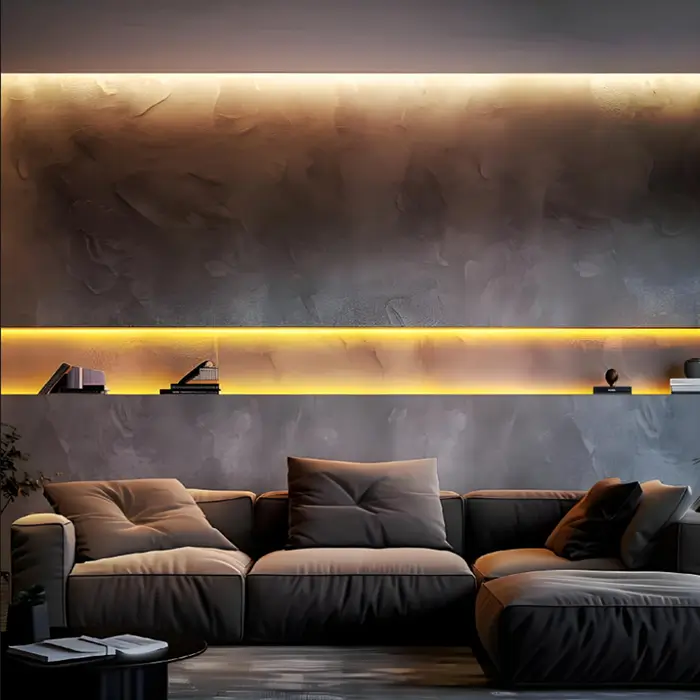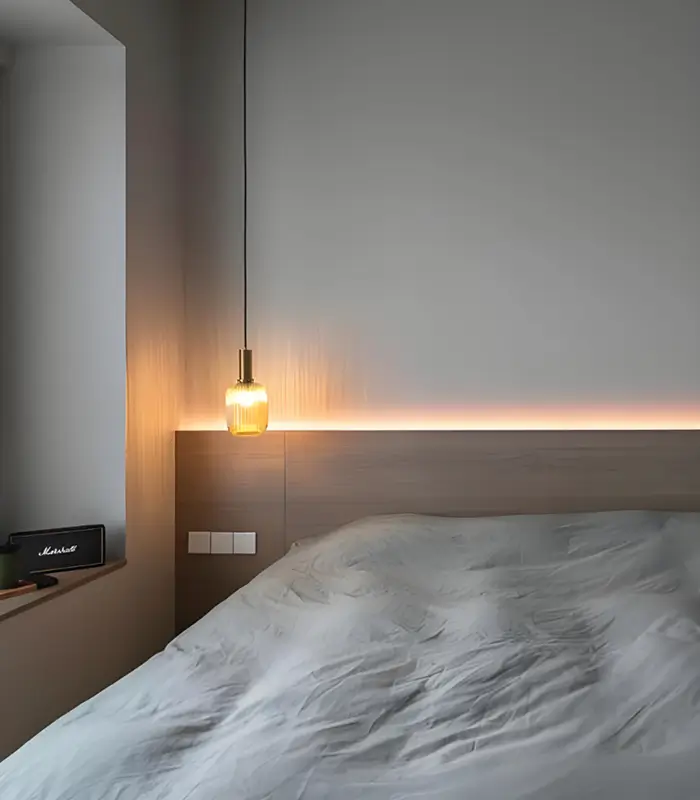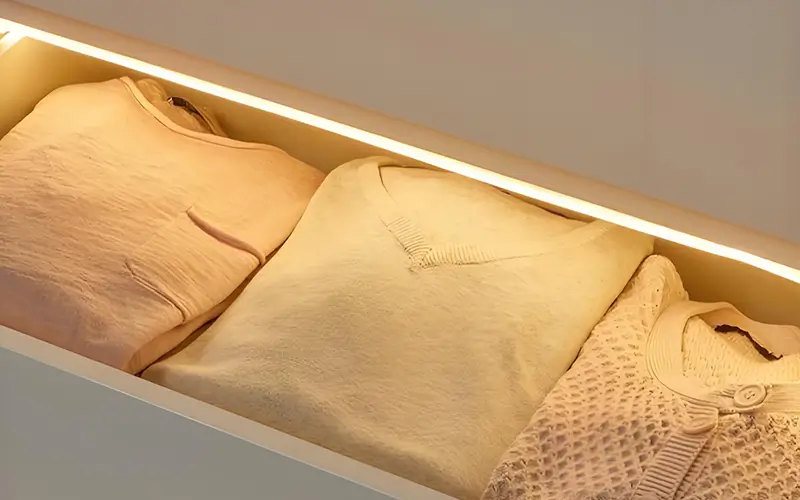LED strip lights are the new mainstream of indoor lighting installation and have become an important element of modern interior design. Many modern lighting decorations now have no main light design, and generally use LED strip lights with track lights. We recommend the 20 best ways to install an interior LED strip lights, with recommended installation methods and actual effect instructions. Are you interested in referring to them?
1. Indoor ceiling light trough
Generally, the ceiling of the living room where we live indoors has a mezzanine, so we can make use of the space on the ceiling. Choose LED tape to illuminate our ceiling as atmosphere lighting. More details, pls kind check How to install the LED Strip light on Ceiling?

The LED strip lights is embedded in the gypsum board ceiling light trough, and the light strip is hidden with aluminum profiles. This creates soft indirect lighting and enhances the sense of space hierarchy and atmosphere.
2. The edge of the bed
We also consider installing LED light strips on the bed in the bedroom. You can directly use 3M adhesive to stick or hide it on the bottom or around the bed frame, which is simple and easy to operate.
Install LED light strips around the bed, preferably with infrared sensing connectors. This way, when you get up at night, you can sense the human body and turn it off and on. Improve the warmth and safety of the bedroom, and also save energy.
3. TV background lighting
The LED light strip is pasted on the back of the TV or the edge of the background board. It is recommended to reduce the stimulation of the screen’s direct light to the eyes, and at the same time enhance the viewing atmosphere and create a cinematic feeling.
The LED light strip used for movie background lighting can be single-color, 3000K or 4000K. The next is the ambient color temperature, using RGBW or RGBIC light strips with remote control/mobile phone APP control.
4. Under the kitchen cabinet
The LED light strip can be installed at the bottom of the cabinet facing the work surface to provide the main lighting for cooking and cooking. Of course, it is also necessary to match the LED aluminum profile + frosted cover with a cold white light strip.
This can provide bright lighting for cooking operations, avoid shadows, and enhance the practicality and beauty of the kitchen. More information, pls check Are LED Tape Lights Good for Under Kitchen Cabinets?
5. Open bookshelves/display cabinets

The user can install LED strip lights on all kinds of open and wardrobes at home, pasted under each layer of partitions. Or embedded in the profile on the back side. It is recommended to use high CRI neutral white light strips.
Generally, we also can choose the infrared sensor lights. Which will light up when turned on and turn off when turned off. This can highlight the details of displayed items or clothes and create an art gallery-style visual effect.
6. Stair treads or skirting
If the house is a duplex or has stairs, we can paste the light strip under each step, or bury it in the side wall skirting groove. You can install it according to your preference.
Install LED strip lights on the stairs to improve the safety of walking on the stairs at night, while presenting a modern linear light and shadow design.
7. Corridor lighting
LED light strips can be installed in the indoor corridor, on the ceiling and the foot line. Combined with the door-controlled infrared sensor switch. When we get up at night, it can be sensed and lit, which is convenient and safe.
8. The back of the bathroom mirror
The light strips are pasted on the four sides of the back of the mirror in the bathroom or washbasin or embedded in the mirror cabinet. Waterproof grade light strips (IP65 or above) must be used.
This decorative style creates a high-end hotel style, with natural fill light. Suitable for delicate operations such as makeup and shaving.
9. The edge of the ceiling above the dining table
Embed the light strip at the outer edge of the ceiling chandelier or the edge of the shape. And choose warm white or adjustable color temperature light strip.
In this way, you can change the color temperature, and brightness of the LED light strip according to your needs. The LED light strip focuses on the dining table area to create a warm and cozy dining atmosphere.
10. Sofa background wall
Install the light strip in the groove behind the wall or soft bag in the living room, and match it with RGB or color temperature adjustable light strip.
Mainly used in living rooms and leisure areas, which will enhance the background level and enhance the artistic sense of space, suitable for creating a leisure atmosphere at night.

11. Under the desk or on the back of the desk
If it is a desk in a study or children’s room, we can put the light strip at the bottom of the desk or the edge of the wooden board behind it. This can provide soft light auxiliary lighting, protect the eyes, reduce shadows, and is suitable for writing and learning.
12. Edge of the partition glass door
If there is a glass door at home, we can consider installing LED light strips. Stick the light strip on the inside of the glass frame and use profiles with good light-guiding effect. Let the glass partition glow, full of technology, and create a futuristic space.
13. Inside the wine cabinet or bar
If there is a public wine cabinet at home, you can attach the LED light strip to the back or top of the wine rack, and add a micro switch or remote control. It can enhance the display effect and improve the quality and style of the overall space.
14. Embedded in the wall shape
If the indoor wall is decorated with wood or plaster, you can consider embedding LED light strips. The light of such LED light strips outlines the wall contours and enhances the sense of detail of the decorative structure.
15. Behind the bedroom headboard
If the bedroom bed has a headboard, we can hide the light strip at the edge of the headboard. It is recommended to use warm white or RGB dimming light strip.
It can create a warm and soft sleeping atmosphere. And you can also read a book before going to bed, which helps you sleep.

16. Ceiling and wall connection line
Install LED strip lights in the transition area between the ceiling and the wall, and then use LED linear aluminum profiles to hide the light strips. In order to ensure that the light is evenly projected and avoid seeing the lamp body. It is recommended to choose aluminum profiles with milky white diffusers.
This installation method can cleverly soften the boundary between the ceiling and the wall. Making the entire space more visually unified and smooth.
The projection of indirect light sources not only enhances the three-dimensional sense of space, but also creates a warm and peaceful atmosphere. Especially suitable for bedrooms, living rooms or leisure areas.
17 Bathroom sink bottom
We install LED strip lights at the bottom of the sink is a practical and beautiful lighting method, especially suitable for modern minimalist or light luxury style bathrooms.
However, you must choose LED light strips with a waterproof rating of IP65 or above, which can provide soft auxiliary lighting under the sink to avoid the ground area being too dim due to the shadow of the main light.
18. Inside a drawer or cabinet

Installing an inductive LED light strip inside a drawer or cabinet is a very smart and convenient solution. The light strip should be installed on the top or both sides of the inner wall to ensure that the light can evenly cover the entire space without glare.
At night or in a dimly lit environment, it can instantly light up the entire storage space, greatly improving the efficiency of finding items. At the same time, the uniform linear light source of the light strip also makes the interior space look neater and more orderly.
19. Bottom of furniture
Fix the LED light strip aluminum profile neatly along the bottom edge of the furniture (about 1-2 cm from the ground). With the light strip facing the ground or slightly tilted inward 5-10° to avoid the light beads directly entering the eyes.
The light diffuses downward, forming a soft “halo” under the furniture. As if the furniture is suspended in the air, significantly reducing the sense of bulk.
20. Ceiling and wall connection line
Installing LED light strips at the corner where the ceiling and the wall meet is a classic way to achieve indirect lighting and a sense of spatial layering.
This lighting method can effectively weaken the rigid boundary between the wall and the ceiling, making the space appear softer and smoother.
Conclusion
LED light strips have become an indispensable element in modern home lighting design with their flexibility, versatility and diverse color temperature changes. The above are 20 creative ways to install LED strip lights for indoor lighting, suitable for different spaces and scenes. Each method provides detailed installation instructions and expected lighting effects. If you need to find a high-quality LED light strip factory, please contact us.
FAQs
Common voltages for indoor LED light strips include 12V, 24V and 5V. 12V is generally selected for short-distance installation, and 24V is recommended for long-distance installation. As for 5V, it is mostly used in USB interface power supply scenarios, such as decorative night lights and desktop atmosphere lights.
The color temperature of indoor light strips is usually selected according to the functional area, but the more commonly use warm light, 2700K and 3000K, of course, the kitchen also needs neutral white 4000K and 5000K.
Most indoor LED light strips come with 3M tape on the back. You only need to tear off the protective film to stick it. It is suitable for flat and clean surfaces (such as cabinets, mirror edges, and wall wire troughs).
Generally speaking, choose IP20 non-waterproof LED light strips for indoor use.. If you want to install it at the bottom of the bathroom sink or around the mirror, it is recommended to use IP65 or above protection level.
